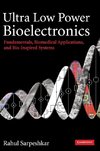
-
 Anglický jazyk
Anglický jazyk
High Frequency Circuit Design
Autor: Ali Behagi
This textbook treats the High Frequency Circuit Design from a practical hands-on approach. Almost all subject matters in the book are accompanied by design examples. University students and practicing engineers will find this book both as a potent learning... Viac o knihe
Na objednávku
71.82 €
bežná cena: 79.80 €
O knihe
This textbook treats the High Frequency Circuit Design from a practical hands-on approach. Almost all subject matters in the book are accompanied by design examples. University students and practicing engineers will find this book both as a potent learning tool and as a reference guide. The textbook introduces techniques that may not be familiar to some engineers. This includes subjects such as the frequent use of the MATLAB Script capability in designing discrete and distributed impedance matching networks. The organization of the book is as follows:
In chapter 1, a thorough analysis of RF and microwave concepts and components are presented. Components such as, straight wire, flat ribbon, physical resistors, physical capacitors, and physical inductors are analyzed and their input impedance are simulated.
In chapter 2, propagation of the plane waves in different media is introduced. Popular types of transmission lines such as coaxial, microstrip, stripline, and waveguides are defined and their parameters are analyzed. Several transmission line components are modeled and their electrical performance are discussed. Microstrip bias feed and directional couplers are also designed.
In Chapter 3, derivation of RF and microwave network parameters, development and use of the network S parameters, and the movement of the lumped and distributed elements on the Smith chart are presented.
In the first half of Chapter 4, the subject of series and parallel resonant circuits, the effect of load resistance on the bandwidth, the tuning and optimization of the circuit components, and design of the tapped capacitor and inductor are discussed. In the second half of the chapter, design of the low pass and high pass filters, generation of the physical models, and construction of the filter prototypes are presented.
In Chapter 5, the conditions for maximum power transfer and the equations for matching any two impedances with are derived. Both analytical and graphical techniques are used to design narrowband and broadband matching networks. Derivation of equations for the Q factor and the number of L-networks, designing with Q curves on the Smith chart, Fano's limit theorem, and the effect of finite Q on the matching networks are also treated.
In Chapter 6, analytic design equations for quarter-wave transformer and single-stub matching networks are derived. Narrowband and broadband distributed matching networks are designed. For the broadband case, the cascaded quarter-wave transformer and the single-stub matching networks are used.
In Chapter 7, single-stage amplifiers are designed by utilizing two different impedance matching objectives. The first amplifier is designed for maxim gain where the input and the output are conjugate matched to the source and load impedance; the second amplifier is a low noise amplifier where the transistor is selectively mismatched to achieve a specific Noise Figure;
- Vydavateľstvo: Techno Search
- Rok vydania: 2018
- Formát: Hardback
- Rozmer: 260 x 183 mm
- Jazyk: Anglický jazyk
- ISBN: 9780996446679











 Nemecký jazyk
Nemecký jazyk 
